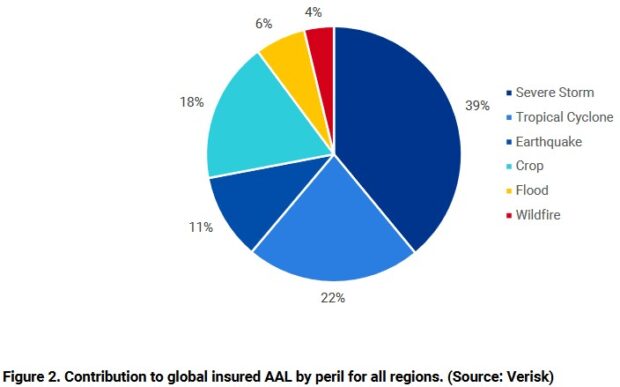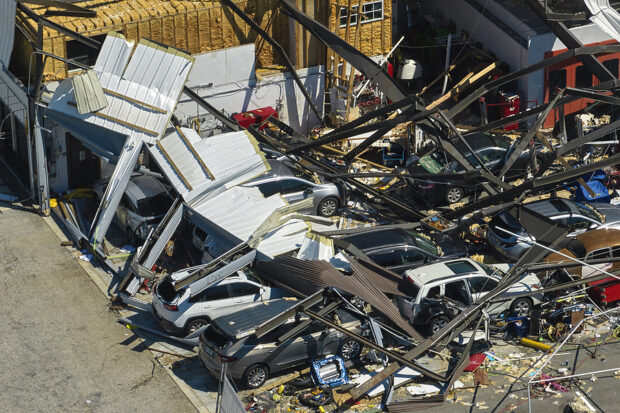The average annual loss from natural catastrophes has increased to $133 billion, a new high, according to latest analysis using Verisk’s extreme event solutions models..
The increase in losses, driven by exposure growth and inflation, is up significantly over the past decade, according to the “2023 Global Modeled Catastrophe Losses Report” published by Verisk.
The report indicates the insurance industry should be prepared for total insured losses from natural catastrophes to exceed $100 billion each year, with annual losses greater than $200 billion also plausible.
“The growth in exposure values, driven primarily by continued construction in high-hazard areas, and rising replacement costs—largely due to inflation—are the most significant factors responsible for increasing catastrophe losses,” said Bill Churney, president of Verisk extreme event solutions.
In addition, climate change is a factor also driving up natural catastrophe loss costs.
Noting that climate change is often cited as the primary reason for the increase in losses, Churney said, that while it plays a role, “year-over-year growth of exposure and rising replacement values have a far greater short-term impact,” Churney added.
“Even a 4.3 percent increase in exposure value and repair costs per year due to higher inflation would result in a more than 50 percent increase in losses over a 10-year period,” Verisk stated.
Flood, severe thunderstorm and wildfire losses account for a much larger proportion of the overall annual losses than hurricanes and earthquakes, due to a combination of more frequent events and more valuable properties at risk.
Over the past five years, severe thunderstorms have been responsible for a growing proportion of losses, the Verisk report noted. As a result, severe thunderstorms shouldn’t be considered a “secondary peril”.
This year alone, severe thunderstorms accounted for more than 70 percent of insured losses with eight multi-billion-dollar events, according to Verisk’s analysis.
The report added that the contribution to the Global Average Annual Loss (AAL) insured from severe thunderstorms is nearly 40 percent. 
Severe thunderstorms in the U.S. account for the majority of the losses, making up 21 percent of the total global AAL.
Global insured losses make up approximately a third of global economic losses.
Verisk went on to estimate that annual economic losses could exceed $400 billion, a figure highlighting the global insurance protection gap.
“The sizable difference between insured and economic losses—the protection gap—represents the cost of catastrophes to society,” the Verisk report stated.
Regionally, the percentage of economic loss resulting from natural disasters that is insured varies.
In North America, about 51 percent of the economic loss from natural disasters is insured, while in Asia, insured losses account for only about 12 percent of economic losses, respectively, reflecting the very low insurance penetration in these regions, the report noted.
The Verisk AAL is generally the sum of losses that can be expected, on average, every year.
The companies models indicate significantly higher losses are expected to occur with relatively high frequencies.
According to the year’s report, Verisk estimates the global insured 100-year loss at $370 billion.
“Probabilistic catastrophe modeling remains the best approach for understanding risk and (re)insurers can use these models, with current exposure information, to put recent losses in perspective, while accounting for the impacts of continued exposure growth, climate change, and the increased role of perils beyond tropical cyclones and earthquakes,” said Churney.





















 AIG Partners With Amwins, Blackstone to Launch Lloyd’s Syndicate Using Palantir
AIG Partners With Amwins, Blackstone to Launch Lloyd’s Syndicate Using Palantir  A Practical Blueprint: The Five Plays of an Innovation Culture
A Practical Blueprint: The Five Plays of an Innovation Culture  Executives on the Move at HSB, American Modern Insurance Group, AIG
Executives on the Move at HSB, American Modern Insurance Group, AIG  The Future of Knowledge in Insurance: From Training to AI-Powered Productivity
The Future of Knowledge in Insurance: From Training to AI-Powered Productivity 